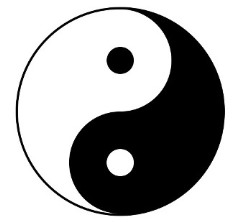
One aspect of Daoism that I return to again and again in my writing practice is that of yin and yang.
The concept of yin and yang is subtler and more complex than we are often led to believe here in the West. Yet, even a basic grasp of it has helped me understand my own writing process.
When my writing slows down, gets muddled, goes through bursts of creativity, or begins to take me places I didn’t expect, I can understand what is happening by thinking of yin and yang.
If you are familiar—even a little—with Eastern thought, you already know the basics.
Yin is the cool, dark, yielding aspect of existence. It is the still, the quiet, the passive, and the submissive. It is completion.*
Yang is the hot, bright, energetic aspect: Active, moving, advancing, and creative. It is conception and beginning.*
Yin and yang are seen as pervading everything—the workings of the Universe, the natural world, human life. All experiences, events, and objects comprise mixtures of yin and yang.
Here is how I see them playing out in my writing practice:
Yin is submission to the writing process. When I stop trying to be active and allow the words to come as they will, it is yin. When I’m yielding to the work itself—letting it take its natural shape, this is yin. Yin is the flow I go into when I give up trying to be in charge. It is my stepping back when the work is complete.
Yang is the burning energy of creativity. It is the blaze of words across the page when I’m at the height of a project. It is that first draft, when I’m charging through. On days when I have to just keep advancing on the page, it is yang. Yang operates when an idea first appears and I need to make it tangible in words.
In the West, we are used to dualistic thinking. Things are going well or poorly. A project is a success or failure. You’re either happy or sad. Yin and yang don’t work that way. Here is why:
1. You can’t have one without the other. They are unified aspects of a whole. Your writing doesn’t work unless you can both take charge and yield, both create and allow creation to take place through you, both start and complete your work.
2. Yin and yang work with each other, not against each other. Western thinkers sometimes try to turn them into opposing forces. They aren’t. They’re complementary and co-operative. I don’t have to choose between them. They are both equally necessary.
3. They balance each other. That balance is one of the most important things in nature and in human life. Too much of one or the other either makes my writing over-controlled and rigid or turns it into much.
4. They are constantly transforming into each other. In the taijitu (or yin/yang symbol), yin reaches a peak, then becomes yang, and yang does the reverse. In writing, I sometimes begin by charging through, then discover that, at some point, I have yielded control: Yang became yin. At others, when I am allowing my writing to go where it wishes, it veers into unworkable slush, and I automatically take charge: Yin becomes yang.
5. They contain each other. In the taijitu, there is a spot of yang on the yin side, and a spot of yin on the yang side. Whenever I am writing, I know there are elements of both yin and yang at all times. When I am yielding, there is still a part of me that is in charge. When I am taking charge, there is still a part that is submitting to the writing. Completion is contained within conception, and a new beginning is inherent in completion.
Yin and yang originally referred to two sides of a mountain: a sunlit side, and a side in shadow. I like that image. The two sides are not contradictory to each other. They don’t battle each other. One doesn’t try to dominate the other. Without a sunlit side, there would be no shady side, and vice versa. They are equally necessary. Without either, there would be no mountain.
Do you see yin and yang acting in your writing? Try applying them to your process and see what comes up.
*NOTE: While, traditionally, yin is female/feminine and yang is male/masculine, I’m not on board with this distinction, which is just too gendered for me. Despite arguments that all people, things, and activities are blends of both yin and yang, the identification of femaleness with passivity and submission and maleness with activity and advancement assumes too much about gender, in my
Although I’ve been writing on and off for many years, I have found that as I’ve grown older I am only now understanding that writing is not a matter of opposites or competing sides. I’ve always grasped that both sides need to exist but until now I’ve not really looked at it in this yin/yang way of needing both and both flowing one into the other, being part of the other. I agree with you, Jill, that the gender based definitions don’t feel quite right, but I think that maybe instead of female/male, we could think more of yielding/unyielding in nature. Thanks for this blog entry. It’s opened up a new way of thinking for me.
Hi Mary. Thank you for commenting! I’m so glad this post was helpful to you. I agree: Yielding/unyielding, retreating/advancing, passive/active–those dichotomies work better than female/male. Good way of thinking about it.